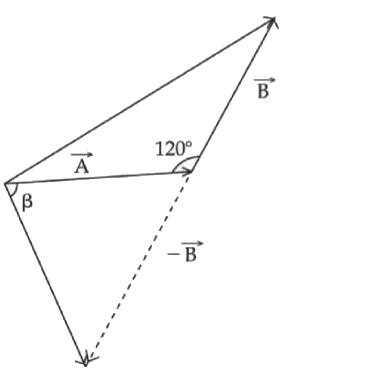A vector →A ur is rotated by a small angle △θ radian (△θ<l) to get a new vector ¯¯¯B In that case ∣∣→B−→A∣∣ is:
∣∣→A∣∣△θ
∣∣→B∣∣△θ−∣∣→A∣∣
∣∣→A∣∣(1−△θ22)
0
To solve the problem of finding the magnitude of the difference between the vectors →B and →A after rotating →A by a small angle θ, we can follow these steps:
Step 1: Understand the Rotation of Vectors
When a vector →A is rotated by a small angle θ, the new vector →B can be represented in terms of →A and the angle of rotation.
Step 2: Use the Law of Cosines
The magnitude of the difference between the two vectors can be calculated using the law of cosines. The formula for the magnitude of the difference between two vectors →A and →B is given by:
|→B−→A|=√|→A|2+|→B|2−2|→A||→B|cos(θ)
Step 3: Substitute the Magnitudes
Since |→A|=|→B| (the magnitudes are equal because the rotation does not change the length of the vector), we can denote this common magnitude as A:
|→B−→A|=√A2+A2−2AAcos(θ)
This simplifies to:
|→B−→A|=√2A2(1−cos(θ))
Step 4: Use the Small Angle Approximation
For small angles, we can use the approximation:
1−cos(θ)≈θ22
Thus, substituting this into our equation gives:
|→B−→A|=√2A2⋅θ22=√A2θ2=Aθ
Step 5: Final Result
Therefore, the magnitude of the difference between the vectors →B and →A after rotation by a small angle θ is:
|→B−→A|=Aθ
Conclusion
The final answer is Aθ.
---
When a vector →A is rotated by a small angle θ, the new vector →B can be represented in terms of →A and the angle of rotation.
The magnitude of the difference between the two vectors can be calculated using the law of cosines. The formula for the magnitude of the difference between two vectors →A and →B is given by:
|→B−→A|=√|→A|2+|→B|2−2|→A||→B|cos(θ)
Since |→A|=|→B| (the magnitudes are equal because the rotation does not change the length of the vector), we can denote this common magnitude as A:
|→B−→A|=√A2+A2−2AAcos(θ)
This simplifies to:
|→B−→A|=√2A2(1−cos(θ))
For small angles, we can use the approximation:
1−cos(θ)≈θ22
Thus, substituting this into our equation gives:
|→B−→A|=√2A2⋅θ22=√A2θ2=Aθ
Therefore, the magnitude of the difference between the vectors →B and →A after rotation by a small angle θ is:
|→B−→A|=Aθ
The final answer is Aθ.
Topper's Solved these Questions
Similar Questions
Knowledge Check
- Question 1 - Select One or More
→A+→B=→C. Vectors →Aand→B if rotated by angle θ in the same sense to from →Aand→B then (θ≠0):
A→A+→B=→CB→A+→B≠→CC→A.→B=→A.→BD∣∣→A+→B∣∣=∣∣→C∣∣ - Question 2 - Select One
If →a and →b are unit vector and θ is the angle between then, then ∣∣∣→a−→b2∣∣∣ is:
Asinθ2BsinθC2sinθDsin2θ - Question 3 - Select One
The angle between vectors (→A×→B)and(→B×→A) is :
Aπ radBπ2 radCπ4 radDzero
Consider three vectors →a,→band→c. Vectors →aand→b are unit vectors having an angle θ between them For vector veca,|→a|2=→a.→a If →a⊥→band→a⊥→cthen→a∣∣→b×→c If →a∣∣→b,then→a=t→b Now answer the following question: The value of sin(θ2) is (A) 12∣∣→a−→b∣∣ (B) 12∣∣→a+→b∣∣ (C) ∣∣→a−→b∣∣ (D) ∣∣→a+→b∣∣
View SolutionConsider three vectors →a,→band→c. Vectors →aand→b are unit vectors having an angle θ between them For vector veca,|→a|2=→a.→a If →a⊥→band→a⊥→cthen→a∣∣→b×→c If →a∣∣→b,then→a=t→b Now answer the following question: If →c is a unit vector and equal to the sum of →aand→b the magnitude of difference between →aand→b is (A) 1 (B) √2 (C) √3 (D) 1√2
View SolutionTwo vectors →A and →B are such that →A+→B=→A−→B. Then
View SolutionUnit vectors →aand→b ar perpendicular , and unit vector →c is inclined at an angle θ to both →aand→b.Ifα→a+β→b+γ(→a×→b) then.
View SolutionIf →a and →b are unit vectors inclined at an angle θ, then the value of ∣∣→a−→b∣∣ is
View Solution


